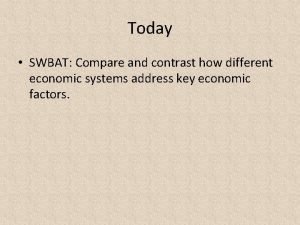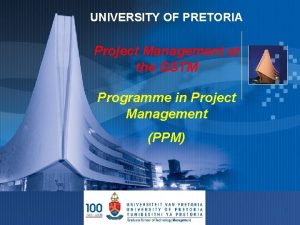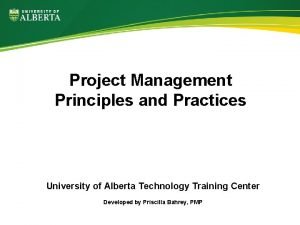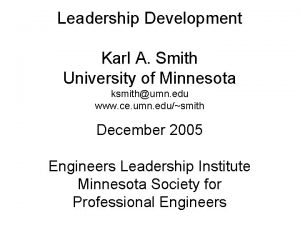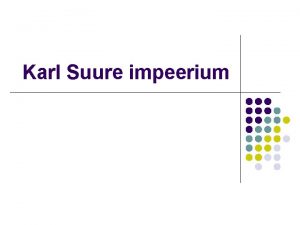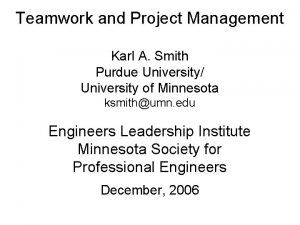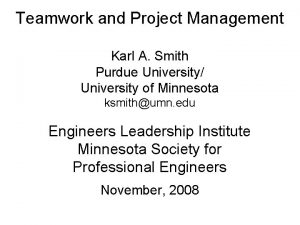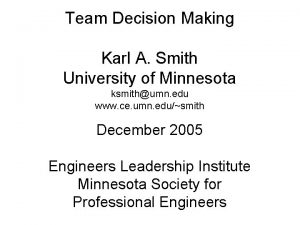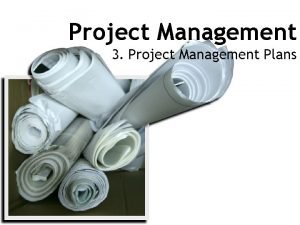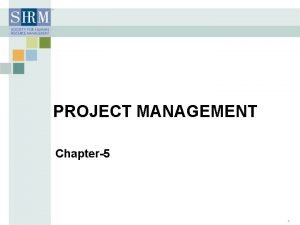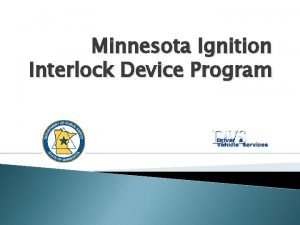Project Management Karl A Smith University of Minnesota
























- Slides: 24

Project Management Karl A. Smith University of Minnesota ksmith@umn. edu www. ce. umn. edu/~smith ISE 5101 September 28, 2001

Successful Projects 1. Take a moment to recall one of your most successful projects 2. Describe it briefly 3. Listen as others describe their successful projects 4. List common characteristics 2

A recent survey of technology projects in the United States by the Project Management Institute reveals some startling percentages. Close to half of the projects started were never finished, 30% were completed but took at least twice as long as expected, some took 5 times as long. Only 10% of the projects were finished on time.

Critical Success Factors and Their Importance for System Implementation (Listed in decreasing order of correlation) 1. Project mission. Initial clearly defined goals and general directions. 2. Top management support. Willingness of top management to provide the necessary resources and authority/power for implementation success. 3. Schedule plans. A detailed specification of the individual action steps for system implementation. 4. Client consultation. Communication, consultation, and active listening to all parties impacted by the proposed project. 5. Personnel. Recruitment, selection, and training of the necessary personnel for the implantation project team. 6. Technical tasks. Availability of the required technology and expertise to accomplish the specific technical action steps to bring the project on-line. 7. Client acceptance. The act of "selling" final product to its ultimate intended users. 8. Monitoring and feedback. Timely provision of comprehensive control information at each stage in the implementation process. 9. Communication. The provision of an appropriate network and necessary data to all key actors in the project implementation process. 10. Troubleshooting. Ability to handle unexpected crises and deviations from plan.

What is a project? (Cleland Kerzner, 1985; Nicholas, 1990) • … a combination of human and nonhuman sources pulled together in a temporary organization to achieve a specified purpose. • Features – – – – Definable purpose with established goals Cost, time and performance requirements Multiple resources across organizational lines One-time activity Element of risk Temporary activity Process with phases/ project life cycle 5

Project Success: Quadruple Constraint

Project Planning Projects typically start with at Statement of Work (SOW) provided by the client. The statement of work is a narrative description of the work required for the project. A Project Charter is often developed. Planning starts with the development of a Work Breakdown Structure (WBS). A WBS is ‘a deliverable-oriented grouping of project elements which organizes and defines the total scope of a project’ (PMBOK, 1996). There are typically three to six levels in WBSs -- program, project, task, subtask, etc. Developing a work breakdown structure is important for scoping a project, i. e. , determining the specific tasks that have to be completed, choosing appropriate groupings for these activities, and setting precedence and interdependence (what has to follow what and what can be going on at the same time).

www. lewisinstitute. com

Creating a Project Charter 1. Write an Overview of the Project Scope 2. Determine the Team’s Boundaries for Creating the Deliverables 3. Define the Customer’s Criteria for Acceptance 4. Determine the Required Reviews and Approvals 5. Establish Risk Limits 6. Select the Project Leader and Team Members 7. Set Deadlines for Delivery of the Final Deliverables 8. Set Limits on Staffing & Spending 9. Create a List of Required Reports 10. Identify Organizational Constraints & Project Priorities. 11. Assemble a Project Charter Martin, P. & Tate, K. 1997. Project Management Memory Jogger. GOAL/QPC.

charterform. pdf 10

Office Remodeling Project The following activities must be accomplished to complete an office remodeling project: Activity Estimated Duration (Days) Procure Paint 2 Procure New Carpet 5 Procure New Furniture 7 Remove Old Furniture 1 Remove Old Carpet 1 Scrub Walls 1 Paint Walls 2 Install New Carpet 1 Move in New Furniture 1

Office Remodeling Project - WBS Procure Paint Procure New Carpet Procure New Furniture Prepare Remove Old Furniture Remove Old Carpet Scrub Walls Install Paint Walls Install New Carpet Move in New Furniture

13

14

Scheduling Problem - CPM Bus Shelter Construction Example Job Name Duration Resources Predecessor(s) 1 Shelter Slab 2 2 5 2 Shelter Walls 1 1 1 3 Shelter Roof 2 2 2, 4 4 Roof Beam 3 2 2 5 Excavation 2 3 6 Curb and Gutter 2 3 5 7 Shelter Seat 1 2 4, 6 8 Paint 1 1 7 9 Signwork 1 2 2, 6

16


Bus Shelter Construction Critical Path Method Results ACT NAME DUR RES LATE EARLY FLOAT ST FN TOT FREE CUR CRIT start PATH 1 Shelter Slab 2 2 2 4 0 0 2 YES 2 Shelter Walls 1 1 4 5 0 0 4 YES 3 Shelter Roof 2 2 8 10 0 0 8 YES 4 Roof Beam 3 2 5 8 0 0 5 YES 5 Excavation 2 3 0 2 0 0 0 YES 6 Curb and Gutter 2 3 2 4 6 8 4 1 2 NO 7 Shelter Seat 1 2 8 9 0 0 8 YES 8 Paint 1 1 9 10 0 0 9 YES 9 Signwork 1 2 5 6 9 10 4 4 5 NO

Estimating Activity Duration 1. Activity length between 0. 5% and 2% of project duration. If an activity takes a year, each activity should be between a day and a week. 2. Critical activities that fall below this range should be included. 3. If the number of activities is very large (say, above 250), the project should be divided into subprojects, and individual schedules developed for each.

Homework Assignment 1 Develop a Statement of Work (SOW), a Project Charter, and Complete a Work Breakdown Structure (WBS) and a Critical Path Schedule for a project (or subproject) from your workplace or experience

Characteristics of ‘Effective’ Project Managers? 1. Formulate your response to the question individually 2. Share your answer with a neighbor 3. Listen carefully to your neighbor's answer 4. Work together to Create a new answer through discussion

What is takes to be a good project manager --Barry Posner (1987) Communications (84% of the respondents listed it) Listening Persuading Organizational skills (75%) Planning Goal-setting Analyzing Team Building Skills (72%) Empathy Motivation Esprit de Corps Leadership Skills (68%) Sets Example Energetic Vision (big picture) Delegates Positive Coping Skills (59%) Flexibility Creativity Patience Persistence Technological Skills (46%) Experience Project Knowledge

Skills necessary for effective project managers -Pinto and Kharbanda (1995): Planning • Work breakdown • Project scheduling • Knowledge of PM software • Budgeting and costing Organizing • Team building • Establishing team structure and reporting assignments • Define team policies, rules and protocols Leading • Motivation • Conflict management • Interpersonal skills • Appreciation of team members' strengths and weaknesses • Reward systems Controlling • Project review techniques • Meeting skills

Keys to success as a project manager--Lientz and Rea (1996): • Communicate regularly in person with key team members • Keep management informed • Keep informed on all aspects of the project • Delegate tasks to team members • Listen to input from team members • Be able to take criticism • Respond to and/or act on suggestions for improvement • Develop contingency plans • Address problems • Make decisions • Learn from past experience • Run an effective meeting • Set up and manage the project file • Use project management tools to generate reports • Understand trade-offs involving schedule and budget • Have a sense of humor
 Compare and contrast, karl marx and adam smith venn diagram
Compare and contrast, karl marx and adam smith venn diagram Whos karl marx
Whos karl marx Mn vdl
Mn vdl University of minnesota surplus
University of minnesota surplus University of minnesota software
University of minnesota software University of minnesota reputation
University of minnesota reputation Traditional vs modern project management
Traditional vs modern project management Ppm university of pretoria
Ppm university of pretoria Project management practices and principles
Project management practices and principles University management system dbms project
University management system dbms project The role of project management in achieving project success
The role of project management in achieving project success Process discriminants in software project management
Process discriminants in software project management Project cost-duration graph
Project cost-duration graph Modern project management began with what project
Modern project management began with what project What is strategic assessment in software project management
What is strategic assessment in software project management Types of project audit in project management
Types of project audit in project management Ms project agile
Ms project agile Varieties of project termination
Varieties of project termination Dr ian smith injury management consultant
Dr ian smith injury management consultant Tat test ap psychology
Tat test ap psychology Mn dnr biomes
Mn dnr biomes Minnesota ikiz çalışmaları
Minnesota ikiz çalışmaları Fccla
Fccla Mmpi minnesota multiphasic personality inventory
Mmpi minnesota multiphasic personality inventory Buffalo ridge minnesota
Buffalo ridge minnesota
